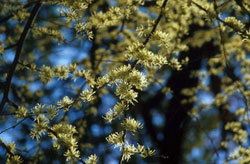Witchhazels – Strikingly Beautiful Plants For The Wintergarden
 Witchhazel
Witchhazel
Through the gray and somber wood
Against the dusk of fir and pine
Last of their floral sisterhood
The hazel’s yellow blossoms shine.
-John G. Whittier (The Hoosier poet…)
Sadly, most American gardeners are more likely to know Witchhazel as a bottle of astringent in their drug cabinet rather than as a beautiful winter blooming shrub. Witchhazel’s beauty is unmatched in the winter landscape, though it is rarely seen in American gardens.
Hamamelis virginiana or the Common Witchhazel is a native shrub scattered throughout the woodlands of eastern North America. It grows into an attractive tree with a beautiful branching habit. This shrub often provides a spectacular display of golden yellow leaves in autumn, followed by subtle saffron yellow flowers with a delicate fresh scent. Because of its large size and habit, the Common Witchhazel is probably best suited to large naturalized areas.
Hamamelis x intermedia, a large and ever-expanding group of hybrid Witchhazels, are some of the most strikingly beautiful plants in the wintergarden and are much more suitable for the home landscape. These hybrids are the result of a cross between the Japanese Witchhazel (Hamamelis japonica) and the Chinese Witchhazel (Hamamelis mollis). The foliage of many of these newer cultivars is spectacular in the fall, ranging from vivid yellows to vibrant reds. Other varieties of Witchhazel have a troublesome trait holding onto their brown leaves long into winter, largely obscuring their delicate blooms.
Hamamelis x intermedia cultivars much later in the winter season, after the leaves have fallen, sometime between January and March, depending on the specific cultivar and its location. In general, these cultivars produce more spectacular flower displays than the straight species with larger and more vibrant petals. Their frilly thread-like flowers come in a much wider range of hues, with lemon yellow, deep golds, rich orange reds and robust burgundies. These hybrids are among the most fragrant of all Witchhazels.
Witchhazels prefer a moist, well-drained soil, very high in organic matter. They are adaptable to either shady or sunny locations, though the flower display will typically be more spectacular in full sun. A dark evergreen backdrop will help to intensify the subtle flower display, although nothing is more beautiful than a Witchhazel in full bloom backlit by the early morning sun. Once established, these plants are relatively trouble free, unbothered by most insects and diseases

Comments (0)